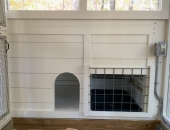




permaculture wiki: www.permies.com/permaculture




 So I will take the hint and get a picture when I get some free time.
So I will take the hint and get a picture when I get some free time.permaculture wiki: www.permies.com/permaculture




Rob S. aka Blitz wrote:
Im going to assume that after 42 views no one can visualize what Im thinkingSo I will take the hint and get a picture when I get some free time.





permaculture wiki: www.permies.com/permaculture




Rob S. aka Blitz wrote:
The watering system will be some kind of rectangular container like a garbage can, it will be pretty large so it will hold maybe 8 gallons of water at a time, and self metering into a little dish. I plan on hooking up a heat source under the floor of the watering system that can be removed and easily accessed for plugging in etc. At this point, I think a 60 watt lighbulb fixture in a metal casing should transfer enough heat to the watering dish to keep it from freezing.




permaculture wiki: www.permies.com/permaculture




permaculture wiki: www.permies.com/permaculture




Rob S. aka Blitz wrote:
Is this still not clear? Any suggestions for how to communicate this better?
 You seem to have everything covered.
You seem to have everything covered.~ I don't talk to people with closed minds; They tend to harbor brain fungus. ~




 My next plan is to do a 3D rendering of the design for everyone so we can get a better picture of the details. That is a bit of work so I was hoping to head off any obvious issues right of the bat since this is my first time with chicks. My biggest concern is the dimensions of everything and the issues that I mentioned above. Does anyone have any insight to any of those concerns? Thanks!
My next plan is to do a 3D rendering of the design for everyone so we can get a better picture of the details. That is a bit of work so I was hoping to head off any obvious issues right of the bat since this is my first time with chicks. My biggest concern is the dimensions of everything and the issues that I mentioned above. Does anyone have any insight to any of those concerns? Thanks!permaculture wiki: www.permies.com/permaculture




permaculture wiki: www.permies.com/permaculture




find religion! church
kiva! hyvä! iloinen! pikkumaatila
get stung! beehives
be hospitable! host-a-hive
be antisocial! facespace




permaculture wiki: www.permies.com/permaculture




Rob S. aka Blitz wrote:
5. As for the waterer, I was thinking that the water could get dirty really quick as well. I have to put some more thought into the design at this point, otherwise I will go with the suggestions put forth.




permaculture wiki: www.permies.com/permaculture









find religion! church
kiva! hyvä! iloinen! pikkumaatila
get stung! beehives
be hospitable! host-a-hive
be antisocial! facespace




permaculture wiki: www.permies.com/permaculture





find religion! church
kiva! hyvä! iloinen! pikkumaatila
get stung! beehives
be hospitable! host-a-hive
be antisocial! facespace




permaculture wiki: www.permies.com/permaculture





find religion! church
kiva! hyvä! iloinen! pikkumaatila
get stung! beehives
be hospitable! host-a-hive
be antisocial! facespace




permaculture wiki: www.permies.com/permaculture




permaculture wiki: www.permies.com/permaculture





find religion! church
kiva! hyvä! iloinen! pikkumaatila
get stung! beehives
be hospitable! host-a-hive
be antisocial! facespace




Be kinder than necessary, for everyone you meet is fighting some kind of battle.




permaculture wiki: www.permies.com/permaculture




 I read that 6' fencing will keep most birds in. My original hens woudn't even go over a 4' fence, but the ones that a neighbor 'gifted' me, were major flyers...and taught the others!
I read that 6' fencing will keep most birds in. My original hens woudn't even go over a 4' fence, but the ones that a neighbor 'gifted' me, were major flyers...and taught the others! Be kinder than necessary, for everyone you meet is fighting some kind of battle.




Be kinder than necessary, for everyone you meet is fighting some kind of battle.




permaculture wiki: www.permies.com/permaculture




permaculture wiki: www.permies.com/permaculture




 )
)Be kinder than necessary, for everyone you meet is fighting some kind of battle.




Be kinder than necessary, for everyone you meet is fighting some kind of battle.





Be kinder than necessary, for everyone you meet is fighting some kind of battle.




permaculture wiki: www.permies.com/permaculture




Be kinder than necessary, for everyone you meet is fighting some kind of battle.




permaculture wiki: www.permies.com/permaculture

















|
rubbery bacon. rubbery tiny ad:
GAMCOD 2025: 200 square feet; Zero degrees F or colder; calories cheap and easy
https://permies.com/wiki/270034/GAMCOD-square-feet-degrees-colder
|



